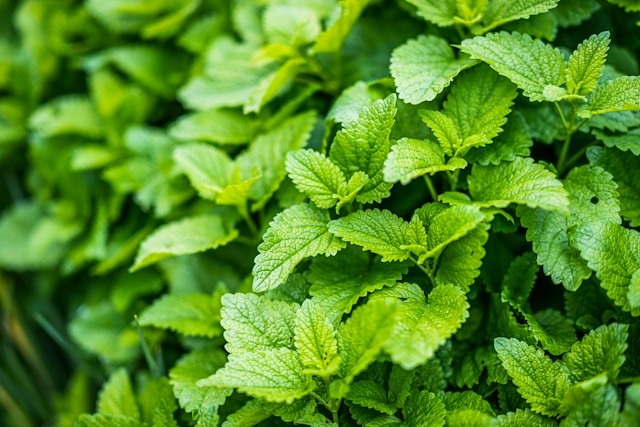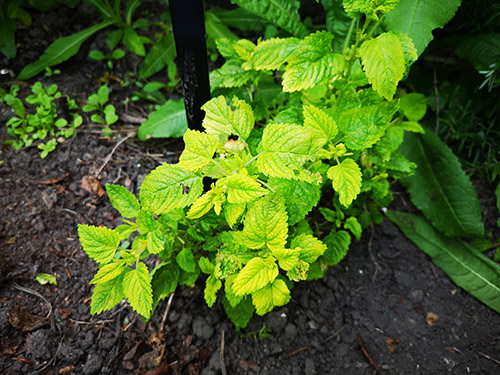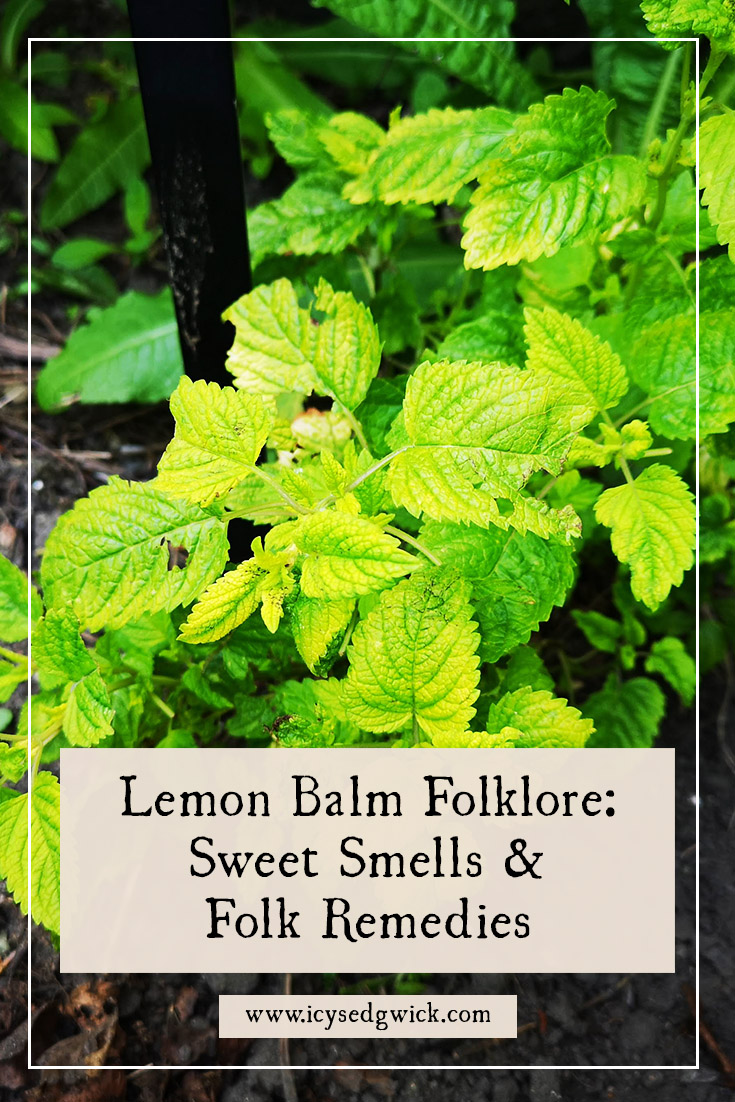Lemon balm, or Melissa officinalis, is a member of the Lamiaceae family, along with mint, rosemary, marjoram, sage, basil, and lavender. Its popular name comes from the fact the leaves smell of lemon when crushed. Lemon balm is a perennial, growing across Europe, North America, and Asia.
That gorgeous lemon smell certainly came in handy. Elizabethan Londoners included lemon balm in their tussie mussie bouquets to help mask the smells of the street (Inkwright 2019: 98).
In contemporary witchcraft, balm makes a popular ingredient in incense used for healing, reducing grief, or boosting the memory (Margaret 2023: 84). It’s also a plant that appears in folk remedies and herbalism alike, without accruing much folklore as an actual plant.
In the Victorian language of flowers, balm meant “sympathy” (Burke 1867: 10). Given how many ailments it seems to treat, it was probably a good bet to send to ill patients!
But let’s dig into the folklore of lemon balm…
Lemon Balm and Bees
Lemon balm is associated with bees and beekeeping in Europe. The Melissa part of its botanical name comes from the Greek word for honeybee. At one stage, people called it melissophyllum, or bee leaf (Inkwright 2019: 97). That’s not to be confused with bee balm, or the Monarda plant. It’s also part of the Lamiaceae family, found in North America, but it’s not the plant we’re looking at here.
According to Greek legend, lemon balm was prolific at temples to Artemis as a favourite plant of the honeybees. A nymph called Melissa guarded the bees (Inkwright 2019: 98).
Pliny the Elder thought balm delighted bees more than any other plant (Harrington 2020: 21). Unlike a lot of his other stuff, he wasn’t far off the mark. It turns out the leaves apparently contain a lot of the same chemicals as bee pheromones (Inkwright 2019: 98).
This explains why people used lemon balm in Bulgaria and Turkey to encourage honeybees to return to a hive. They also rubbed new hives with the leaves so swarms settle there (Inkwright 2019: 98). It’s certainly preferable to the bees choosing to swarm and go elsewhere.

Oddly, despite bees’ preference for balm, some think it can deter other insects. A respondent to Plant-Lore.com said her mother brewed a batch of lemon balm and bathed her dog in it while the dog was in season to keep insects away (Vickery 2010).
Balm for Mental and Emotional Health
Arab physicians in the ninth and tenth centuries used balm to help with worry or uneasiness (Harrington 2020: 21). Mildred Fielder relates a remedy of adding crushed lemon balm leaves to hot water to soothe the nerves and even flavour food (1975: 230).
This might not have been too far off the mark. A 2014 study saw lemon balm added to drinks and yoghurt for participants, who reported reduced anxiety (Scholey et. al. 2014). More research is needed, but it’s fascinating to see this study appear to support what these Arab physicians already knew.
In contemporary witchcraft, it appears in magical workings for uplifting the mood, healing, and attracting love. Unlike more obvious love-related plants like rose, lemon balm is more likely to bring in a gentle and compassionate partner. Simply growing and tending lemon balm is supposed to help this to happen (Margaret 2023: 85). Astrologer William Lilly placed balm under the rulership of Venus, so this link with love makes sense (1647: 75).

You can also infuse lemon balm in the home to lift the mood of those within (Harrington 2020: 21). One way to do so is by adding lemon balm to floor washes to help cleanse rooms after illness or arguments (Margaret 2023: 85). A study in 2004 found lemon balm did reduce psychological stress induced in the lab (Kennedy et. al. 2004). True, it did only test 18 people, and more research is needed, but it’s a good place to start.
This may explain why people in the eastern Mediterranean region used lemon balm to help drive off evil spirits (Binney 2018: 102).
A respondent to Plant-Lore.com from Derbyshire advised drinking lemon balm tea during a sleepless night to bring on drowsiness (Vickery 2010). Again, there may be some truth to this. A 2006 study showed that children with insomnia enjoyed a whopping 70-80% improvement when taking a combined dose of valerian and lemon balm (Müller 2006). Again, more research is needed.
Ancient to Early Modern Medicine for Physical Ailments
Balm appears in a range of medical remedies for physical ailments, as well as those affecting the heart or mind. As always, none of this post constitutes medical advice so if you have a medical issue, consult your healthcare practitioner.
Not to hype lemon balm up, or anything, but Paracelsus thought lemon balm would revive anyone who was unwell (Harrington 2020: 21).
Herbalist John Gerard claimed it could drive off melancholy when added to wine and drunk. To be fair, he did also say it was “good against the bitings of venemous beasts” (1597: 560). He also suggested using the juice of balm on open wounds, and it was more efficient if you added the juice to an oil or unguent for this purpose (1597: 560).

According to Maud Grieve, this actually worked because the balsamic oils of plants provided anti-putrescent effects. Dressing wounds with such plant-based material meant the oil sealed the wound or sore as it dried and blocked oxygen from reaching the germs (1995-2021).
Its aid in healing wounds made with iron led to Dioscorides and Pliny calling balm “ironwort” (1597: 561). Apparently, balm was good at staunching blood if you tied it to the sword that made the wound, but bear in mind that nugget came from Pliny. This sounds more like sympathetic magic, linking the wound to the weapon that made it. It feels like you’d have been better off staunching blood with the actual lemon balm.
Gerard noted that Arabic physicians found balm to be good for heart problems, and that Ibn Sina prescribed balm to “make the heart merry and joyful”, and that it “strengthened the vital spirits” (1597: 560). Part of this comes from the Doctrine of Signatures, a medical system in which people believed plants cured whatever body part they resembled. Its name comes from the idea that God left his signature on the world to tell people how to use plants and trees. Balm has heart-shaped leaves, and thus is was believed to be good for the heart. Part of me wonders if this connects back to those ideas around reducing anxiety with the plant.
If you mixed the leaves with salt, Dioscorides claimed balm could soothe the King’s Evil, hard swellings, or gout pain (Gerard 1597: 560).
More Realistic Uses of Lemon Balm for Physical Health
These are all lofty claims for lemon balm. How about more achieveable uses of balm for your physical health?
Some think it can improve your life expectancy. Llewellen, Prince of Glamorgan lived to be 108. He cited cups of lemon balm tea every morning and night as the secret to his longevity (Baker 2011 [1969]: 23). Likewise, John Hussey of Sydenham apparently drank balm tea with honey every morning for fifty years, and lived to 116 (Grieve 1995-2021).
Grieve provides a recipe of 1 pint of boiling water for every ounce of lemon balm, which you infuse for fifteen minutes, let it cool, strain it, and then drink. She adds you can put sugar and lemon peel in it it you want a summer drink (1995-2021). If you’re on any medication, do check with your doctor first as balm can interfere with some prescriptions. Those with mint allergies should avoid ingesting it at all.
But it does have some other folk uses. A respondent to Plant-Lore.com from Derbyshire advised a lemon balm infusion to reduce itching during the later stages of chickenpox (Vickery 2010). Another respondent from Gloucestershire advised lemon balm tea for stomach problems or colic (Vickery 2010).
Again, this may have some basis in fact. A 2010 study plied those suffering with functional dyspepsia with sorbet, both with and without added lemon balm, after a meal (Gasbarrini et.al. 2010). The version with lemon balm lessened their symptoms. And again, more research is needed!
What do we make of the folklore of lemon balm?
Much like the iris, the thing that fascinated me while researching this post was the relative lack of folklore. Lemon balm appears in remedies for its uses, whether that’s related to physical, emotional, or mental health. Even its appearance in antiquity is related to its uses, through its ability to attract bees. Very useful plants often have a lot of folklore, reflecting how useful they are – look at nettles – but here, the uses remain and the lore doesn’t.
It’s relatively easy to grow from seed, although it’s best to do this indoors between March and May. You can transfer the seedlings outside when the frost has passed. Lemon balm likes sun and light shade, in well-draining moist soil. As you might imagine, it’s a great choice if you want to attract bees to your garden (RHS 2024). Or why not grow one indoors on a sunny windowsill and enjoy the ensuing domestic harmony?
What do you make of lemon balm? Let me know below!
References
Baker, Margaret (2011 [1969]), Discovering the Folklore of Plants, third edition, Boxley, Oxford: Shire Classics (aff link).
Binney, Ruth (2018), Plant Lore and Legend, Hassocks: Rydon (aff link).
Burke, Mrs L. (1867), The Illustrated Language of Flowers, London: G. Routledge & Co.
Fielder, Mildred (1975), Plant Medicine and Folklore, New York: Winchester Press.
Gasbarrini, G., Zaccone, V., Covino, M., Gallo, A. (2010), ‘Effectiveness of a “cold dessert”, with or without the addition of a mixture of digestive herbs, in subjects with “functional dyspepsia”‘, Journal of biological regulators and homeostatic agents, 24 (1), pp. 93-98.
Gerard, John (1597), The Herball or Generall Historie of Plantes, London: John Norton.
Grieve, Maud (1995-2021), ‘Balm’, Botanical.com: A Modern Herbal, https://botanical.com/botanical/mgmh/b/balm–02.html.
Harrington, Christina Oakley (2020), The Treadwell’s Book of Plant Magic, London: Treadwells Books.
Inkwright, Fez (2020), Folk Magic and Healing: An Unusual History of Everyday Plants, London: Liminal 11 Press.
Kennedy, David O., Little, Wendy, & Scholey, Andrew B. (2004), ‘Attenuation of laboratory-induced stress in humans after acute administration of Melissa officinalis (Lemon Balm)’, Psychosomatic medicine, 66 (4), pp. 607–613.
Lilly, William (1647), Christian Astrology, London: John Partridge and Humphrey Blunden.
Margaret, Annabel (2023), The Green Witch’s Guide to Herbal Magick: A Handbook of Green Hearthcraft and Plant-Based Spellcraft, London: Quercus.
Müller, S.F., Klement, S. (2006), ‘A combination of valerian and lemon balm is effective in the treatment of restlessness and dyssomnia in children’, Phytomedicine, 13 (6), pp. 383-387.
RHS (2024), ‘How to grow lemon balm’, RHS, https://www.rhs.org.uk/herbs/lemon-balm/grow-your-own.
Scholey, Andrew, Gibbs, Amy, Neale, Chris, Perry, Naomi, Ossoukhova, Anastasia, Bilog, Vanessa, Kras, Marni, Scholz, Claudia, Sass, Mathias, Buchwald-Werner, Sybille (2014), ‘Anti-Stress Effects of Lemon Balm-Containing Foods’, Nutrients, 6 (11), pp. 4805-4821.
Vickery, Roy (2010), ‘Balm’, Plant-Lore.com, https://www.plant-lore.com/balm/.
Nutty about folklore and want more?
Add your email below and get these posts in your inbox every week.
You'll also get my 5-step guide to protecting your home using folklore!








Have your say!